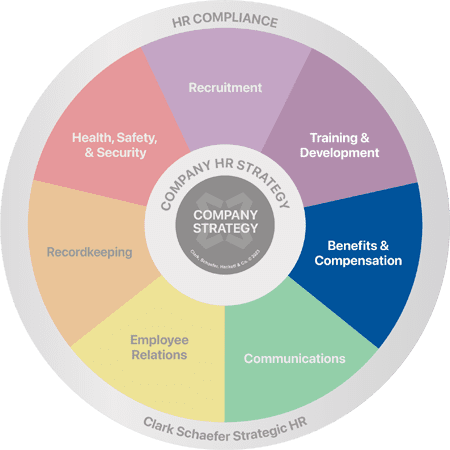Aligning Compensation with Strategic Business Imperatives
Last Updated on November 2, 2022 / Benefits & Compensation
by Linda Gravett, Ph.D., SPHR, CEQC
A compensation philosophy relates to an organization’s commitment to how it values employees. A consistent and intentional pay philosophy gives both the organization and its employees a frame of reference when discussing salary in a negotiation. The goal of a compensation philosophy is to attract, retain and foster an environment that motivates employees. For organizations in the private sector, this typically requires a competitive pay philosophy. In the public and nonprofit sectors the focus is on benefits and the employees’ sense of value in the contributions their work provides to society.
Organizations attract, develop and retain quality employees through a total compensation approach. To accomplish this, astute compensation strategists use a mixture of the three main ingredients of a compensation system: base pay (salary); incentive pay such as cash or stocks; and benefits (rewards such as life and health insurance). A sound approach is a blend of all three.
An organization’s pay philosophy might be to offer salaries that are competitive in the industry, or it may decide to offer pay to attract junior level employees rather than senior level. In order to retain loyal and proficient seasoned workers, perhaps tailored benefits such as long-term disability will be offered. The challenge is to create a compensation system that includes all three components without exhausting the company’s resources.
Many organizations have a compensation philosophy that includes paying a competitive base salary that’s comparable to what employees could get somewhere else doing similar work. Additionally, if employees have equity in the company, that’s a powerful incentive to do well and encourage co-workers to excel. Another excellent incentive is the use of a signing bonus and later on, a retention bonus. The key, according to my research over the last 20 years, is to reward high-performers well to demonstrate their value in meeting strategic business imperatives.
Another consideration is whether your company wants to lead or lag the market with salaries and salary adjustments. Even though many companies review salaries only once a year, the marketplace is continuously moving. A company’s compensation, then, is likely to be at market value just once a year. As a consequence, companies must decide what time of year to offer raises and whether to lead the market at the beginning of the year and lag behind at the end of the year, or to lag behind at the beginning of the year and lead at the end.
Yet another consideration is whether to pay for employee proficiency or longevity, or a combination of both. The formula for employee proficiency involves calculating a comparatio — the employee’s salary compared to market. For example, if an employee earns 45,000 and the median in the marketplace for that job is $50,000, the employee has a comparatio of 90%. If this employee has worked at this comparatio for long, the company is at risk of losing him or her, especially if the employee is highly proficient.
The advantage of paying for proficiency is that the market value of jobs is tied to skills. Employers can assess how their employees stack up on any number of measures related to these skills. The Society for Human Resource Management (SHRM), at www.shrm.org, has numerous articles on developing a matrix of measures related to skills and compensation.
Under protective labor laws, a compensation program must be consistently carried out across all employees and cannot discriminate based on illegal factors such as race, gender, or disability. Companies have the absolute right, however, to differentiate based on factors such as level of position and skill sets required to perform a job.
I’ve found that organizations always benefit from being transparent about their compensation philosophy. A consistently followed, well-developed philosophy will make sense to employees and result in a sense of fairness. This approach can also be a strong recruiting tool, especially in today’s marketplace in which 20–somethings want to understand career growth opportunities before accepting a position. During a salary negotiation for a new employee, consider which would come across more positively: “My final offer is $65,000 and I can’t pay a dollar more”, or “My final offer is $65,000 which is at 100% of market.”
If your company hasn’t been intentional about a compensation philosophy in the past, I encourage you to think about it now. Underpaying or overpaying employees can cost the company in the long run, either in turnover or unnecessarily high salaries.
For more information on this topic, contact Dr. Linda Gravett at lsg@justthebasics.com orLinda@gravett.com.




